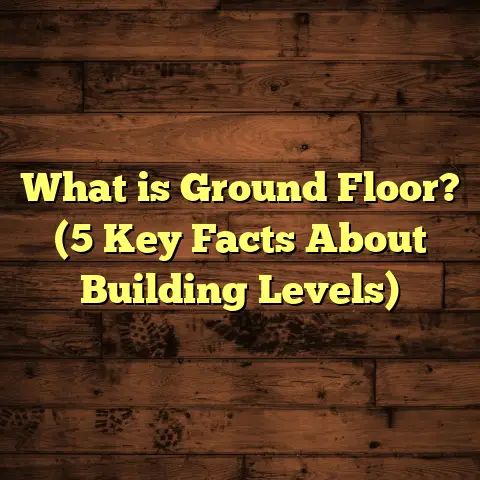What is Cheaper: Laminate or Wood Flooring? (5 Key Cost Factors)
How to Decide Between Laminate and Wood Flooring Without Breaking the Bank
Choosing the right flooring for your home can feel overwhelming.
I’ve been in the flooring business for over a decade, and one
question I hear all the time is: “What’s cheaper — laminate or
wood flooring?” If you’re scratching your head over this, you’re
not alone. I’m going to walk you through five key cost factors that
make a huge difference when you’re weighing these two popular
options.
By the end of this, you’ll have a clear picture of where your money
goes, what you get in return, and which choice fits your budget and
style best.
I remember early in my career, a client came to me completely confused.
She wanted beautiful wood floors but was afraid of the price tag. She’d
heard laminate was cheaper but wasn’t sure if it was worth it. We sat down
and broke down every cost piece by piece — and that’s exactly what I want
to do for you here.
What Is Laminate and Wood Flooring? A Quick Breakdown
Before jumping into costs, let’s get on the same page about what
these floors really are.
Laminate flooring is a multi-layer synthetic product designed to
look like real wood. It has a photographic applique layer under a
clear protective coating. The core is typically made of fiberboard.
Laminate is known for its resistance to scratches and dents and is
generally easier to install.
Wood flooring usually refers to solid hardwood planks cut from
trees like oak, maple, or cherry. It can also include engineered
wood, which has a thin hardwood veneer over plywood layers. Wood
floors provide natural beauty, warmth, and can be refinished many
times.
If you want to get technical, engineered hardwood is something of a hybrid between laminate and solid wood. It has real wood on top but layers underneath that resist moisture better than solid wood does. That can affect cost and durability too.
Let me share an experience: I helped a family in Seattle who wanted the look of hardwood but lived in a damp climate. They chose engineered wood because it balanced cost and moisture resistance better than solid hardwood or laminate.
Understanding these differences is key because each option comes with unique price tags and maintenance needs.
1. Material Costs: What You Pay Upfront
When I first started offering flooring options to clients, the
material cost was the biggest shock for many.
Laminate usually costs between $1 and $5 per square foot. This low
price is because it uses less natural wood and more manufactured
materials.
On the other hand, solid hardwood runs from $5 to $10 per square
foot depending on the species. Exotic woods like Brazilian cherry or
walnut push prices even higher, sometimes up to $15 per square foot.
Engineered wood falls somewhere in between — around $3 to $7 per
square foot — because it uses less hardwood than solid planks.
Over the years, I’ve seen pricing fluctuate slightly with market demands and supply chain factors. For instance, during the pandemic years, some hardwood prices spiked due to shortages in raw lumber — which made laminate an even more appealing budget option for many homeowners.
If you’re working on a 1,000 square foot room:
- Laminate material might cost between $1,000-$5,000.
- Solid hardwood material could range from $5,000-$10,000 or more.
- Engineered hardwood might fall between $3,000-$7,000.
The price difference is significant and often shapes clients’ initial decisions.
Here’s an interesting stat: According to the National Wood Flooring Association (NWFA), the average cost of hardwood flooring materials increased by about 15% from 2019 to 2023 due to demand and shipping costs. Laminate prices stayed relatively stable during this period.
I always tell clients that spending a bit more on higher-quality laminate can pay off by lasting longer and resisting wear better. It’s tempting to grab the cheapest option but that often means replacing it sooner — which adds cost over time.
2. Installation Expenses: DIY or Hire a Pro?
This is where many people underestimate costs.
Laminate flooring is popular with DIYers because it often features
click-lock designs that snap together without glue or nails. I’ve seen
clients install 500 sq ft of laminate in a weekend with basic tools.
If you’re handy, you could save $1 to $2 per square foot on labor by
doing it yourself for laminate.
Hardwood floors usually require professional installation unless you
have experience with precise nailing or stapling techniques. The wood
needs acclimating to room humidity before installation — a step I’ve
seen many skip with poor results.
Professional hardwood installation averages $3 to $8 per square foot.
That includes subfloor preparation, which can add to labor time if your
existing floor isn’t smooth.
In one recent project for a client renovating an old farmhouse, the
subfloor needed leveling and repairs, which added $1,200 extra to labor.
That’s something you won’t face as often with laminate since it’s more
forgiving over minor imperfections.
Let me break down installation steps for both floors:
Laminate Installation Steps
- Remove old flooring
- Check and prep subfloor (level and clean)
- Lay underlayment (foam or cork)
- Snap planks together with click-lock system
- Cut planks at edges for fit
- Install trim and transition pieces
This process is straightforward and doesn’t require nails or glue — making it easier for first-timers.
Hardwood Installation Steps
- Remove old flooring
- Inspect and prep subfloor (often involves sanding or leveling)
- Acclimate wood planks in room for 3-7 days (important for moisture balance)
- Nail or staple planks down firmly
- Sand entire floor after installation (if solid wood)
- Apply stain or finish coats (requires drying time)
Hardwood installation is labor-intensive and requires skill for a smooth finish.
In my experience, labor costs often surprise clients more than material prices do. If you live in an area with higher wages or union labor requirements, expect those prices to rise accordingly.
A tip I share is to always get at least three installation quotes from local contractors so you can compare prices fairly. Some pros also offer package deals including materials that might save you money overall.
3. Longevity and Maintenance: What You Spend Over Time
You might be thinking: “If laminate costs less now but doesn’t last,
is it really cheaper?”
Good question. Here’s what I’ve learned from years of fieldwork:
Laminate floors generally last 10-20 years depending on quality and
wear. They resist stains and scratches but can’t be refinished if they
get damaged; instead, you replace planks or the whole floor.
Wood floors, especially solid hardwood, can last 50+ years if well- maintained. Plus, you can sand and refinish them multiple times, which
restores their look without replacing the entire floor.
Maintenance-wise, laminate needs minimal care — just regular cleaning
with a damp mop and avoiding excess water. Hardwood requires special
cleaners and occasional refinishing every 7-10 years.
Let me tell you about a family I worked with in Denver who had installed laminate flooring when their kids were toddlers. After about 12 years, heavy wear showed up around doorways and play areas. They faced replacing large sections because laminates don’t sand down well.
Contrast that with another client who installed oak hardwood in their living room 30 years ago; they refinished it twice during that time, keeping it looking new without fully replacing any boards.
The long-term maintenance cost of hardwood usually includes:
- Occasional sanding/refinishing ($2-$4 per sq ft)
- Cleaning products specific for wood
- Repairing minor dents or scratches
With laminate:
- Cleaning supplies are cheaper
- But damage can mean replacing whole planks (cost varies by brand)
One useful rule of thumb I share is: If your household has high foot traffic or pets that scratch floors often, laminate might save money in repairs upfront but may need replacement sooner overall.
4. Resale Value: How Your Choice Affects Home Worth
If you’re planning to sell your home someday soon, your flooring choice
can impact the resale price.
I’ve done consultations where sellers upgraded from laminate to hardwood
to increase buyer interest. Studies show homes with hardwood floors sell
faster and at higher prices compared to homes with laminate or carpet.
According to a 2023 report by Remodeling Magazine, hardwood floors recoup
about 70-80% of their cost at resale, while laminate recoups closer to 50-60%.
The National Association of Realtors also reports that 99% of buyers prefer hardwood floors due to their classic look and perceived quality.
I once met a couple selling their suburban home who initially installed laminate throughout the house. When they got their appraisal back, they were surprised that buyers offered less than expected — citing “outdated” flooring as a drawback. They replaced living room and kitchen floors with hardwood before listing again and sold within two weeks at a price $15k higher than original offers.
That said, if selling isn’t on your horizon for years or decades, this factor might weigh less heavily in your decision.
5. Additional Costs: Underlayment, Waste & Repairs
There are smaller costs that add up but are easy to overlook:
- Underlayment: Both laminate and wood require underlayment, but its type varies. Good underlayment improves comfort and soundproofing. For laminate, expect around $0.30-$0.50/sq ft; for hardwood, it might be $0.50-$1/sq ft for moisture barriers and padding.
- Waste Factor: Flooring installers typically add 5-10% extra material cost for cuts and mistakes. Laminate’s lower price means waste costs less overall, but don’t cut corners here—you’ll thank yourself later.
- Repairs: If damage occurs, laminate planks can be swapped out individually but matching colors later can be tricky. Hardwood repairs may need sanding or replacing boards but are usually easier to blend.
Let me share an example: I worked on a condo where the client wanted cheap flooring fast. They picked low-end laminate without budgeting for underlayment or extra waste material. The installer had to order extra boxes twice due to miscuts — increasing costs by nearly 15%. Plus no moisture barrier caused bubbling near kitchen sinks later on.
Another time, an investment property owner chose hardwood but skipped proper underlayment — leading to creaks and noise complaints from tenants that resulted in costly reinstallation work.
These “hidden” expenses can add thousands if ignored upfront.
My Personal Take: Balancing Budget and Beauty
I’ve installed both flooring types in dozens of homes, and here’s what I tell clients:
If your budget is tight and you want quick installation with decent durability, laminate is a smart choice. It looks good enough for most rooms and saves thousands up front.
If you want longevity, natural warmth, and increased resale value — and can spend more initially — solid wood flooring wins hands down.
Remember that not all laminates or woods are created equal. Brands matter. So do installation skills and maintenance habits.
Also think about lifestyle: families with kids or pets may benefit from scratch-resistant laminate even if they love wood’s look. Older adults may prefer wood’s timeless feel despite higher initial cost.
A Case Study From My Experience
Last year I worked on two similar-sized homes in the same neighborhood:
- Home A: 1,200 sq ft laminate installed at $3/sq ft materials + $2/sq ft labor = $6,000 total.
- Home B: 1,200 sq ft solid oak hardwood installed at $8/sq ft materials + $5/sq ft labor = $15,600 total.
Five years later:
- Home A’s laminate floor showed wear in high traffic areas; replacement or repair estimated at $2,000.
- Home B’s hardwood was refinished once ($3,500) but still looked fresh and raised the home’s market value by about $10,000 versus comparable homes without hardwood.
This example shows how upfront savings with laminate might lead to future expenses or compromises in appearance.
Tips From My Toolbox
Ask for detailed estimates: Don’t accept vague quotes; get clear pricing on materials, labor, underlayment, and waste.
Check local labor rates: Installation prices vary widely by region; use online tools like FloorTally for accurate estimates.
Consider room usage: For kids’ rooms or basements prone to moisture, laminate may be better.
Think about style: Wood floors have unique grains that add character; laminates rely on printed images.
Don’t skimp on underlayment: It makes floors feel better underfoot and protects against moisture.
Plan for future maintenance: Budget for refinishing hardwood or replacement parts in laminate timelines.
DIY? Laminate is more beginner-friendly; hardwood usually requires pros unless you have carpentry skills.
Bonus Section: Environmental Impact & Sustainability
More homeowners ask me about how eco-friendly their flooring choices are — which indirectly affects long-term value too.
Laminate floors typically use recycled wood fibers bonded with resin—meaning fewer trees are cut compared to solid hardwood production. However, some laminates release volatile organic compounds (VOCs), so picking low-VOC brands matters for indoor air quality.
Hardwood floors are natural but involve harvesting trees which impacts forests unless sourced responsibly through certifications like FSC (Forest Stewardship Council).
Engineered wood balances this by using thin hardwood veneers over plywood cores made from faster-growing trees or recycled wood products.
I once helped an eco-conscious client select bamboo flooring—a type of engineered wood made from fast-growing grass—because it offered wood-like durability with less environmental strain at a moderate price point ($4-$8/sq ft).
Frequently Asked Questions From My Clients
Q: Can laminate look as good as real wood?
A: High-quality laminates have come a long way in mimicking real wood grains and textures. While they don’t have the depth of natural wood grain or warmth when touched, many people find them visually appealing enough for casual spaces or rental homes.
Q: Is engineered wood worth the extra money over laminate?
A: Yes—engineered wood offers authentic hardwood surfaces with better moisture resistance than solid wood and feels more natural than laminate underfoot. It’s often priced between laminate and solid hardwood too.
Q: How do I maintain my laminate floor?
A: Avoid soaking water; use damp mops or microfiber cloths regularly; clean spills immediately; use furniture pads to prevent scratches; avoid abrasive cleaners.
Q: What about pets? Which floor handles claws better?
A: Laminate generally resists scratches better than softwoods like pine but may chip if claws dig hard enough. Hardwood varies by species; harder woods like oak handle pets better but need refinishing after extensive wear.
Thanks for sticking with me through this breakdown! If you’re still unsure which way to go on your project, feel free to ask me specific questions about your home’s layout or budget — I’m happy to help you figure it out step-by-step. Flooring is an investment that affects your daily living comfort and your home’s value for years to come. Choosing wisely saves headaches and money down the road.





